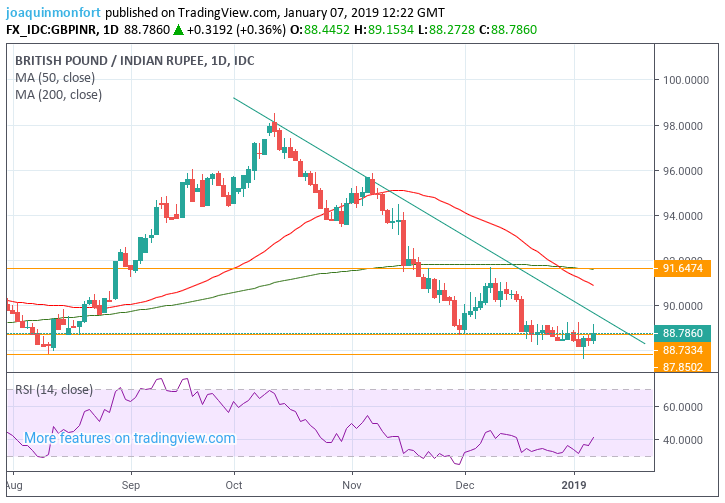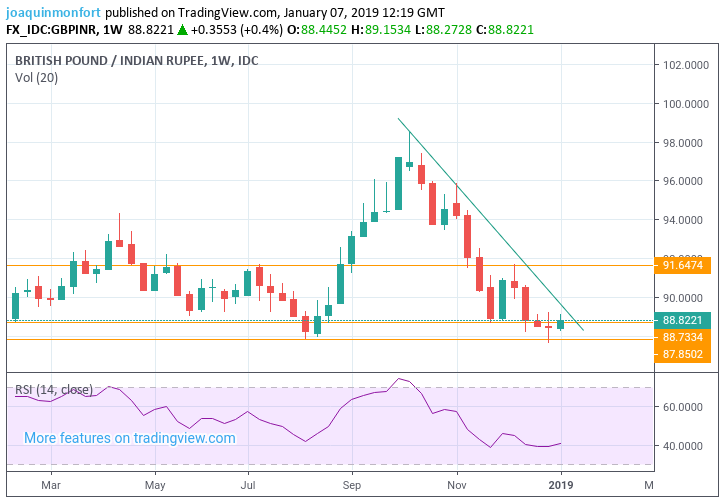The Pound-to-Rupee Rate in the Week Ahead: Oil-driven Downtrend to Continue

© Natanael Ginting, Adobe Stock
- GBP/INR bounces in recent week but downtrend prevails.
- Creak below August low to confirm continuation lower.
- Pound looks to GDP data as Rupee eyes the oil market.
The Pound-to-Rupee rate received a brief flurry of support at the start of the new week but a broader downtrend remains in place and is likely to drag the exchange rate lower during the days and weeks ahead.
GBP/INR is trading at 88.75 at the time if writing, after a receiving a marginal 0.33% uplift at the start of the new week due to Rupee weakness, which was the result of a recovery in oil prices. Oil rose almost 2% on Monday.
However, the pair has been falling ever since October when it struck a post-Brexit referendum high and this downtrend remains intact from a technical perspective.
The exchange rate seems more likely to go on declining than not, so our forecast remains bearish.

Above: Pound-to-Rupee rate shown at daily intervals.
The August low at 88.73 is the next key line in the sand for the exchange rate. This is likely to provide robust support to the market and an initial test could even lead to a substantial bounce.
Last Thursday's key hammer low may have marked a major trough for the pair that could be succeeded by a longer-lived rebound higher. But any such move should prove to be short-lived.
Nevertheless, a clear break below 88.73 is required in order to facilitate a continuation down toward the 85.50 area, which corresponds with the end of 2017's consolidation.
Ideally we'd like to see such a break pierce below 87.50 for us to feel confident about a slide down toward the lower target. Any break above 90.00 would raise serious doubts about the durability of the downtrend.
Our bearish expectations is supported by the crossing over of the 200-day moving average, by the 50-day moving average, known as a 'death cross’.
This is a strong technical signal that suggests further downside for the GBP/INR rate is likely. The pair is also trading below all major moving averages on the weekly chart too, which is a further negative indicator.

Above: Pound-to-Rupee rate shown at weekly intervals.
The Indian Rupee: What to Watch
The main economic release for the Indian Rupee in the week ahead is industrial and manufacturing production data due out on Friday, January 11, at 13.00 GMT.
Industrial production growth is expected to have slowed to an annualised pace of 45 in November, down from the 8.1% increase registered in October. There is no consensus estimate available for manufacturing output, but it rose 7.9% in October.
Another major fundamental driver for the Indian Rupee will be the price of oil, because the country has to import so much of its fuel. When the price falls it means a lesser number of Rupees need to be sold to import the material and vice versa.
GBP/INR has tracked the price of oil lower since October’s peak. Obviously it is not clear whether the price of oil will continue to slide, thus supporting the Rupee, or if it will find a floor and soon recover. Some commentators still see vulnerabilities in the market due to weakening demand from a possible global economic slowdown.
The Pound: What to Watch
The UK enters a critical three week period as parliamentarians return to Westminster to debate the merits of the Government's withdrawal deal with the EU. A vote is due in the week commencing January 14.
At present, the deal is expected to be voted down by legislators amidst a lack of fresh concessions from the EU. The government is expected to bring the deal back before parliament for a second vote in the event of the first vote failing.
However, any second vote must contain some material changes, so we expect the EU to offer something in the near future as they will know only too well that the deal they worked on over the past 2 years will not pass in its current form.
Sterling will likely trade relatively subdued, range-bound levels until the point it becomes clear that either 1) May's deal will pass or 2) a No Deal Brexit is going to happen in March 2019. We will be watching the newswires for any indications that a decisive shift in either direction has occurred.
The Pound's rise on Friday was in part driven by the release of better-than-expected services sector data, but in the week ahead the focus will be more on the heavier parts of the economy with industrial and manufacturing production data for November scheduled for release, as well as, of course, GDP.
Industrial production is forecast to end a 3- month losing streak in November, when it is released at 10.30 GMT, on Friday, and forecast to show a 0.2% rise. Manufacturing is forecast to show a 0.4% gain when it is released at the same time: these would contrast with -0.6% and -0.9% respectively in October.
Monthly GDP data for November is also out at the same time on Friday and is expected to show a 0.1% rise month-on-month, the same as it did in October, and a 1.3% rise year-on-year.
Despite growth in the UK being weak, it remains about the same as in the Eurozone.
“Despite the Brexit gloom and gridlock in Parliament over the withdrawal deal, the UK economy does not seem to have slowed down anymore than its European counterparts and probably managed growth of 0.1% in November, estimates are anticipated to show,” says Rafi Boyadjian, an analyst at broker XM.com.
The other key economic release for the Pound is trade balance data, also out on Friday.
Advertisement
Bank-beating exchange rates. Get up to 5% more foreign exchange by using a specialist provider to get closer to the real market rate and avoid the gaping spreads charged by your bank when providing currency. Learn more here
